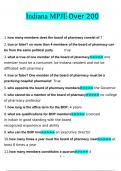College aantekeningen
Lecture notes theme statistics Clinical Research in Practise (CRIP)
- Instelling
- Universiteit Leiden (UL)
Complete lecture notes of the theme statistics in the course Clinical Research in Practice (CRIP) of the master Biomedical Sciences at the LUMC. Lecturers from Bart Mertens.
[Meer zien]













